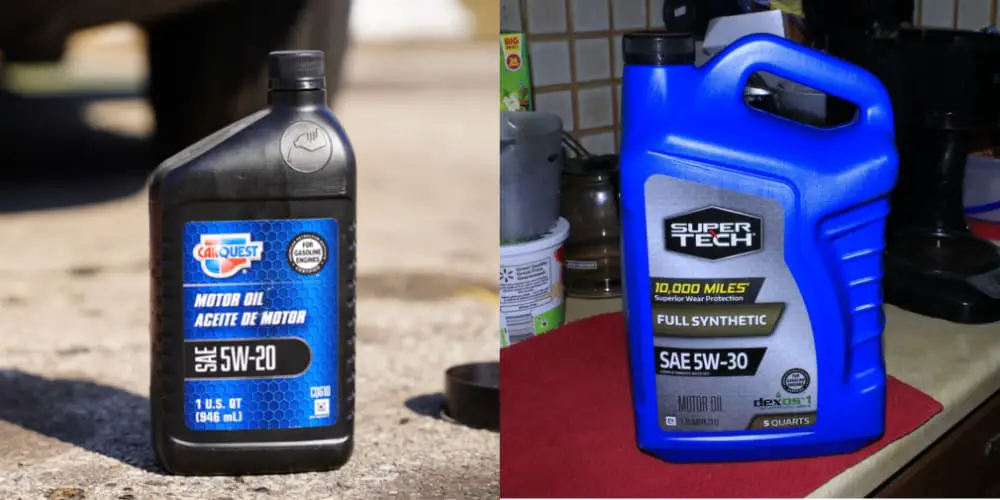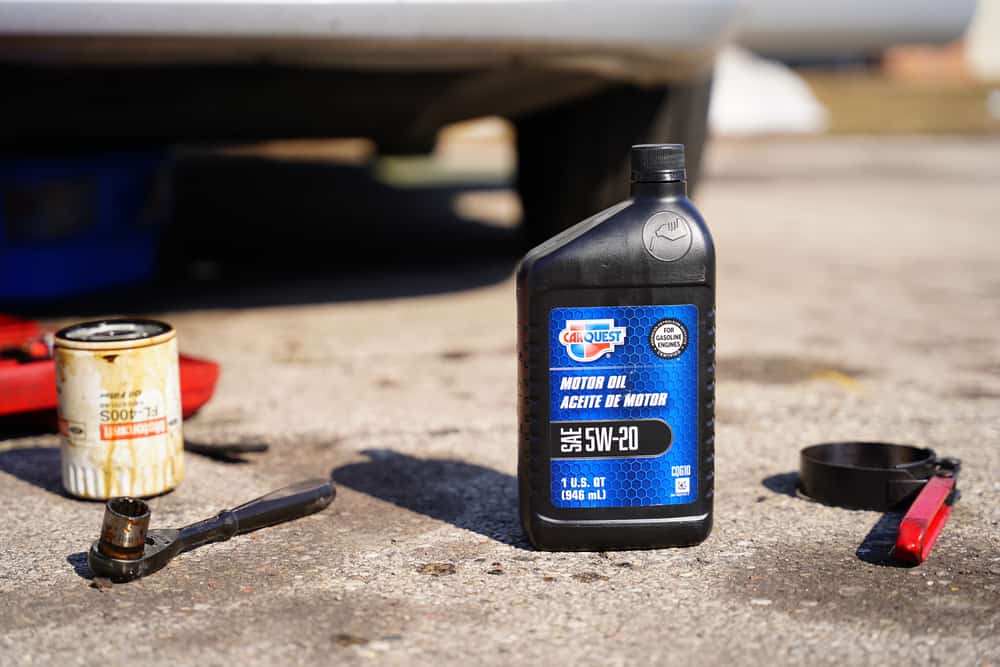
Anyone familiar with basic car maintenance knows that engines use different types of oil. So if your car’s engine is rated for 5w30, it makes sense to have reservations about swapping it for 5w20.
But are your reservations well founded, or are the instances when it actually makes sense to use 5w20 instead of 5w30?
You can use 5w20 at times instead of 5w30, but you’ll want to pay special attention to what’s going on with the environment and climate when you do. 5w20 oil has a lower viscosity than 5w30, which makes it a much better option for colder weather.
If you use 5w20 instead of 5w30 anytime you want to, you are bound to cause problems with your engine. Read on to discover when you can and should use this oil instead of 5w30.
What Happens If You Use 5w20 In a 5w30 Rated Engine?

You’re at the store purchasing new oil. There are multiple options, and many of them look similar. You pick up the 5w20 and hope it’s the right one; but after putting it in your vehicle, you realize you’ve gotten the wrong type.
What should you expect?
People mix up their oils more often than you’d think. It creates issues over time, but they’re usually not apparent upfront.
Putting 5w20 in a 5w30-rated engine isn’t going to hurt the engine immediately. In fact, it would take multiple times of repeating this mistake before it starts to affect the engine.
However, this doesn’t mean you should throw caution to the wind and put whatever oil you want in your engine.
Prolonged use of the wrong oil can significantly reduce your engine’s efficiency. If you do it long enough, you’ll decrease your engine’s lifespan because its moving parts won’t be protected as they should be.
To keep your vehicle in the best running condition, it’s essential to use the same oil every time.
Consistency is your friend when it comes to your vehicles. Not only should you always use the same oil rating, but you should also stick to synthetic or conventional oils rather than switching between the two.
The Difference Between 5w20 and 5w30 Oils
Engine oil has different viscosities, and this is actually captured in the oils’ naming. Each letter in an oil’s naming has a meaning:
- 5: denotes the viscosity of the oil in question when it’s cold.
- W: shorthand for “winter.”
- 20 or 30: shows how viscous the oil in question is when it gets hot.
When hot, 5w30 is typically thicker or denser than 5w20 oil. 5w20 is built to flow easier through the engine when it’s cold. But like other less viscous oils, it offers less protection for your vehicle than its thicker counterparts in warmer conditions.
In other words, 5w20 and 5w30 move differently through the engine at different temperatures. Because 5w30 is thicker, it will flow better when temperatures get hotter.
Of course, your engine always heats up, and all engine oils are built to handle that heat. But when the engine heat is combined with outside heat, you need to be more cautious about what type of oil you use.
All engines will have an oil rating (usually 5w20 or 5w30) that indicates what oil to use in your vehicle. In most cases, you’re better off sticking to what the manufacturer suggests.
If you change it, you should do so at the correct times. If the engine is rated for 5w30 oil, always use this during the warmer months. In the colder months, however, your vehicle may actually benefit from switching to 5w20.
Because 5w20 flows smoother through the engine, it’s an excellent option for winter. In the same way that everything seems to thin in the heat, the opposite is true of the cold. As such, having thinner oil in your vehicle during the colder months can make a big difference in how the engine runs.
Possible Complications With Using 5w20 in a 5w30-Rated Engine
As we discussed, you should still be cautious about using 5w20 in a 5w30-rated engine. While it won’t cause major issues upfront, mixing these two throughout the year will cause problems.
The primary concern is that the engine won’t be well protected when the temperatures get warmer. While 5w20 protects your 5w30 engine during the winter months because of its lower viscosity, it has the opposite effect during the summer.
This means that the 5w20 oil will thin out too much during the hotter parts of the year. As a result, your engine won’t be protected.
If an engine is rated for 5w30 oil, there’s a reason for it. Usually, engines rated for this type of oil need a bit more special treatment than those rated for 5w20.
In most cases, these newer engines have additional features and components that need better protection than older vehicles.
On the other hand, using 5w30 oil in an engine rated for 5w20 won’t result in similar problems.
Generally, these engines can handle the changeover better than their 5w30-rated counterparts. You should still use caution here, however, and perform the oil switches in the same way you would for the reverse.
Why Do Some People Use 5w20 Instead of 5w30?

Some vehicle owners use 5w20 instead of 5w30 because they live in a colder climate.
Even if their engine calls for 5w30, they might require 5w20 since it’s thinner and has a much lower chance of freezing. Using 5w30 in a cold climate means the oil can’t move as quickly, so the engine will suffer.
Here’s a list of additional reasons you might use 5w20 instead of 5w30 and vice versa:
- If your engine is worn and slowing down, 5w20 oil is easier to process. Thinner oil is usually much easier for older engines, too. Since 5w30 oil is thicker than 5w20, it’s harder to process. In these scenarios, 5w20 does a much better job of lubricating all of the moving parts in the engine.
- Oil pans with clump oil should use 5w20 until they get to the nearest mechanic. If you break down on the side of the road because the oil pan is coagulated, 5w20 will always be better than 5w30. It’s much less viscous, which means it won’t add to the clumping. Furthermore, it’ll get to the overheated moving parts much faster.
- Using 5w30 oil will help a 5w20 oil engine if you live in an area that’s always hot or humid. While humidity often loosens 5w30, 5w20 oil will be too thin to handle extreme heat and humidity. After all, 5w30 was created to withstand a wide range of temperatures and humid conditions in many vehicles.
- According to Way, most people prefer 5w30 over 5w20 because it’s used by more vehicles. If you want an oil you can use in most situations, 5w30 is almost always the better option. Although slightly thicker than 5w20, it’s designed to work in most light-duty vehicles for the foreseeable future.
Can You Mix 5w20 and 5w30 Oil?
You can mix 5w20 and 5w30 oil if you already have a small amount of one of these oils in the engine.
However, pouring both oils into the same engine prevents you from receiving any of the benefits each type provides in extreme temperatures, making the mixture pointless.
Furthermore, mixing too much 5w30 into a 5w20 oil reservoir can cause problems in cold climates. The reverse is true, too. If you use a mixture with too much 5w20 in a 5w30-rated engine in extremely hot climates, your engine will be less protected.
Follow these guidelines if you’re determined to mix 5w20 and 5w30:
- Avoid 50/50 mixes if possible. They end up nullifying most of the benefits, making your engine work much harder and hotter than it needs to be.
- Only mix these oils if you’re topping one of them off. For example, if your engine has mostly 5w30 oil, you can add enough 5w20 oil to top it off and reach the correct mark on the dipstick.
- Don’t mix 5w20 oil with 5w30 oil if you live in extreme temperatures. Those living in high heat throughout the year should use 5w30 oil, and those living in freezing climates year-round should opt for 5w20 oil.
Mixing oil usually isn’t a good idea (unless the combination is called for by the manufacturer). However, 5w30 and 5w20 oil are so similar that the mixture typically doesn’t cause engine problems unless used consistently and mixed in incorrect proportions.
For more information on using various oils, check out this article. It answers all your questions about using 10W40 as a substitute for 5w30.
Final Thoughts
Engines are created with an oil rating for a reason. Almost always, the engine will perform best with the original oil rating.
But mistakes happen, and sometimes 5w20 is added to a 5w30-rated engine (and vice versa). When this happens, there’s no need to panic.
It won’t damage your engine in the short term, and in most cases, it can actually benefit the engine when you switch these oils around at the right time of year.
You should always maintain caution, however, when changing oils.
